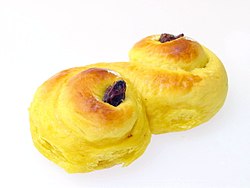 | |
| Alternative names | Saffron cake, saffron loaf, tea treat bun, St Lucia bun, lussebulle, lussekatt |
|---|---|
| Type | Sweet roll or yeasted cake |
| Place of origin | Cornwall, Norway, Sweden |
| Main ingredients | currants or raisins, saffron, cinnamon or nutmeg |
A saffron bun, Cornishtea treat bun or revel bun, is a rich, spiced yeast-leavened sweet bun that is flavoured with saffron and contains dried fruit including currants and raisins similar to a teacake. The main ingredients are plain flour, butter, yeast, caster sugar, currants and sultanas. [1] Larger versions baked in a loaf tin are known as saffron cake.
Contents
- West Country
- Scandinavian St Lucia bun
- Saffron colouring
- See also
- References
- Bibliography
- External links
Similar buns are Swedish lussebulle or lussekatt, Norwegian lussekatt.


